I remember a while ago, there was a lot of talk regarding the MOTU interfaces with SABRE DAC inside, being used for hifi.
The 8a seems to fit your requirements, but you'll have to let JRiver do some downscaling if you want to play DSD files.
Still,... have a look:
MOTU.com - Overview
The 8a seems to fit your requirements, but you'll have to let JRiver do some downscaling if you want to play DSD files.
Still,... have a look:
MOTU.com - Overview
Fair enough just thought it might be a way to test the waters with a different DAC chip. If you like I could send you my D50 in the post to try out. I've got enough other DAC's to get me by for a while 🙂I'd really like to find a solution covering all of it, all 6 channels.
Even on the subwoofers I do use processing, as a sort of Linkwitz transform.
How else am I going to get what I'd want from 12" subwoofers in a pretty small enclosure. Always having to deal with those compromises, you know...
Trying to keep things small has drawbacks...
I remember a while ago, there was a lot of talk regarding the MOTU interfaces with SABRE DAC inside, being used for hifi.
The 8a seems to fit your requirements, but you'll have to let JRiver do some downscaling if you want to play DSD files.
Still,... have a look:
MOTU.com - Overview
Possibly this could be a valid route to take: New Toy - Motu 8A | Audio Science Review (ASR) Forum
The numbers are impressive, I'll say that! As it is an all balanced devise, sume universal buffers could still help get that towards the two SE amplifiers.
Fair enough just thought it might be a way to test the waters with a different DAC chip. If you like I could send you my D50 in the post to try out. I've got enough other DAC's to get me by for a while 🙂
That's a very generous offer. If I would think I have enough time available to really play with it, I'd take you up on it. I have so many thing I need to try first, I haven't even put the subwoofers through DRC-FIR yet, and I expect even better results when I do. I'm still waiting for a couple of days after each other so I can do measurements, processing and measure the results all in one short period. Like I used to do when I had too much time on my hands and not enough money (lol). Right now it's somewhat reversed. I do have a small budget, from which I financed the Ambient amplifier and have some left to make my next choice.
Together with my partner we've sold off an old project, one that I've mentioned here a couple of times. Our Apfelbeck Engine project.
That doesn't make me a rich man, but a small budget is available if I can ever make up my mind which route to go.
Attachments
Last edited:
Due to a question raised by Mark100 over on another thread I decided to play a little with the crossover function in JRiver. I haven't had a use for it but was curious enough to see what it does. As Mark seems to be a fan of things like LR8, I figured I'd try and see how something like that does at say: 8 KHz.
So I made a little test inside JRiver (version 22 by the way, I do own version 26 but haven't used it yet):

If we look in REW, after recording a Dirac pulse to disk we get this view of the frequency traces:

Filtering it with 1/3 octave at 8000 Hz shows us this:


So there's a 0.07 ms difference between the two. I figured I'd have to delay the high frequency by 0.07 ms inside JRiver to get a perfect sum. Let's see what happens:

What do you know, it looks exactly the same... nothing happened. Then I remembered I have REW configured to set the impulse peak at 0. So that must be why I get exactly the same results here.
Importing both original traces again from example 1 with REW set to look for the first sample:

A perfect sum!
So if I were to add the right channel to the left, after these crossovers, without using any delay like this:

We get this as the end result:

So when you set a crossover inside JRiver, in this case I used 2x Butterworth 24db/octave to get the LR8, it will sum together perfectly. So if the drivers acoustic centers are aligned, you'll get a perfect summed crossover.
JRiver's smallest delay is 0.01 ms, in real world distances that would be:

So that is just slightly more than 3 mm.
I'd say it will be harder to get your head equal distance to 2 drivers you're trying to sum than it is to get an acceptable sum in JRiver at 8 KHz. 🙂
I hope this proves that JRiver, even at version 22, is perfectly capable to handle Linkwitz Riley crossovers at higher frequencies.
So I made a little test inside JRiver (version 22 by the way, I do own version 26 but haven't used it yet):
If we look in REW, after recording a Dirac pulse to disk we get this view of the frequency traces:
Filtering it with 1/3 octave at 8000 Hz shows us this:
So there's a 0.07 ms difference between the two. I figured I'd have to delay the high frequency by 0.07 ms inside JRiver to get a perfect sum. Let's see what happens:
What do you know, it looks exactly the same... nothing happened. Then I remembered I have REW configured to set the impulse peak at 0. So that must be why I get exactly the same results here.
Importing both original traces again from example 1 with REW set to look for the first sample:
A perfect sum!
So if I were to add the right channel to the left, after these crossovers, without using any delay like this:
We get this as the end result:
So when you set a crossover inside JRiver, in this case I used 2x Butterworth 24db/octave to get the LR8, it will sum together perfectly. So if the drivers acoustic centers are aligned, you'll get a perfect summed crossover.
JRiver's smallest delay is 0.01 ms, in real world distances that would be:
So that is just slightly more than 3 mm.
I'd say it will be harder to get your head equal distance to 2 drivers you're trying to sum than it is to get an acceptable sum in JRiver at 8 KHz. 🙂
I hope this proves that JRiver, even at version 22, is perfectly capable to handle Linkwitz Riley crossovers at higher frequencies.
Attachments
The Motu 8A uses the same technology as my $200 cheaper Motu Ultralite MK IV. I'm not sure what the difference is. Analog output specs are almost identical. I hope mine measures as well.
I'm not sure what to make of the measurements in the review. They seem better than the Motu and chip specs. They also appear to be as low as the Keysight instrument is capable of measuring accurately. But I trust Keysight, they are the renamed HP Instruments division, which has a storied past.
The first chart shows a noise floor down over 150db from full scale. The paper fluid posted claimed only -137 db but I'm not sure that is apples to apples. With numbers like this, digital volume control seems perfectly OK.
The 2nd chart shows a -1db 1 khz output with 2nd harmonic down 125 db but the spec only claims THD+N of -110db. Since the noise is well below the visible harmonics, this THD+N is all HD. In successive charts the 1 khz output amplitude is reduced in 10 db steps and you can see the HD dropping down into the noise. HD finally disappears into the noise at -60db output level. Reading approximate numbers off the chart, the SNR at that level is still around 95 db.
So with a digital volume control, after turning the volume down 40 db you would still have circa 115 db SNR. That seems more than good enough for me as the NC500 amp is specced at only 110 db SNR at 2.83 volts output, SNR reducing with level as the noise at the output stays constant. As output level reduces amp noise rise relative to DAC noise and eventually becomes greater than it.
The thing to do with these Motu DACs is to set the peak signal level to the full +20dbU output instead of just to the level needed to drive the amp to its peak output. This is necessary to get full SNR from the DAC. It also maximizes the amount of attenuation you need at the input to the amp to set the maximum SPL wherever you want it. This attenuation reduces the DAC noise further relative to the amp noise.
I'm really not trying to convince anyone to get a new DAC, just trying to understand the issues and clean up my previous posts as I grope my way through the data. OTOH, its hard to deny these numbers and measurements. That is not to say one can't get equally or almost equally impressive noise performance from a state of the art 24-bit DAC. Those TI chips I looked at that are used in one of these DACs had a 130 db SNR spec, IIRC.
I'm not sure what to make of the measurements in the review. They seem better than the Motu and chip specs. They also appear to be as low as the Keysight instrument is capable of measuring accurately. But I trust Keysight, they are the renamed HP Instruments division, which has a storied past.
The first chart shows a noise floor down over 150db from full scale. The paper fluid posted claimed only -137 db but I'm not sure that is apples to apples. With numbers like this, digital volume control seems perfectly OK.
The 2nd chart shows a -1db 1 khz output with 2nd harmonic down 125 db but the spec only claims THD+N of -110db. Since the noise is well below the visible harmonics, this THD+N is all HD. In successive charts the 1 khz output amplitude is reduced in 10 db steps and you can see the HD dropping down into the noise. HD finally disappears into the noise at -60db output level. Reading approximate numbers off the chart, the SNR at that level is still around 95 db.
So with a digital volume control, after turning the volume down 40 db you would still have circa 115 db SNR. That seems more than good enough for me as the NC500 amp is specced at only 110 db SNR at 2.83 volts output, SNR reducing with level as the noise at the output stays constant. As output level reduces amp noise rise relative to DAC noise and eventually becomes greater than it.
The thing to do with these Motu DACs is to set the peak signal level to the full +20dbU output instead of just to the level needed to drive the amp to its peak output. This is necessary to get full SNR from the DAC. It also maximizes the amount of attenuation you need at the input to the amp to set the maximum SPL wherever you want it. This attenuation reduces the DAC noise further relative to the amp noise.
I'm really not trying to convince anyone to get a new DAC, just trying to understand the issues and clean up my previous posts as I grope my way through the data. OTOH, its hard to deny these numbers and measurements. That is not to say one can't get equally or almost equally impressive noise performance from a state of the art 24-bit DAC. Those TI chips I looked at that are used in one of these DACs had a 130 db SNR spec, IIRC.
You want dither together with that volume control. Any measurements with it with say -40dB attenuation?
/
/
Wesayso,
and how about using room correction and using the built in presets in there?
Does the Parametric EQ perform better than Room Correction?
and how about using room correction and using the built in presets in there?
Does the Parametric EQ perform better than Room Correction?
Do you mean the Room Correction settings within JRiver?
Where you put in actual distance to each speaker?
This would help to make an asymmetric speaker position sound more symmetric. However I haven't used it once.
As I've setup everything equal distance and where I couldn't I just put in delay where needed (like on ambience channels).
Where you put in actual distance to each speaker?
This would help to make an asymmetric speaker position sound more symmetric. However I haven't used it once.
As I've setup everything equal distance and where I couldn't I just put in delay where needed (like on ambience channels).
Last edited:
The first chart shows a noise floor down over 150db from full scale. The paper fluid posted claimed only -137 db but I'm not sure that is apples to apples. With numbers like this, digital volume control seems perfectly OK.
The 2nd chart shows a -1db 1 khz output with 2nd harmonic down 125 db but the spec only claims THD+N of -110db. Since the noise is well below the visible harmonics, this THD+N is all HD. In successive charts the 1 khz output amplitude is reduced in 10 db steps and you can see the HD dropping down into the noise. HD finally disappears into the noise at -60db output level. Reading approximate numbers off the chart, the SNR at that level is still around 95 db.
Too true! With these new DACs coming out the noise is low enough that additional attenuation gets you very little. Also trying to design an analog volume control that does not disturb those numbers is very very hard. Even a mechanical stepped attenuator with super accurate resistors has potential impedance issues which may lead to linearity issues depending on equipment design.
Using a state of the art DAC and following it with an analog volume control is not for the faint of heart implementation wise. I'd like to see some system wide measurements with analog volume control inline. I'd be willing to bet the measurements are degraded. Wish I could afford an Audio Precision device so this could be shown with measurements. And as you said, the limiting factor for a fair number of DACs will be the amplification.
The whole idea behind using a Motu device like that is to not need any analog attenuation. Something like analog attenuation makes more sense with the current 20 bit capable DAC I have now.
Due to a question raised by Mark100 over on another thread I decided to play a little with the crossover function in JRiver. I haven't had a use for it but was curious enough to see what it does. As Mark seems to be a fan of things like LR8, I figured I'd try and see how something like that does at say: 8 KHz.
So I made a little test inside JRiver (version 22 by the way, I do own version 26 but haven't used it yet):
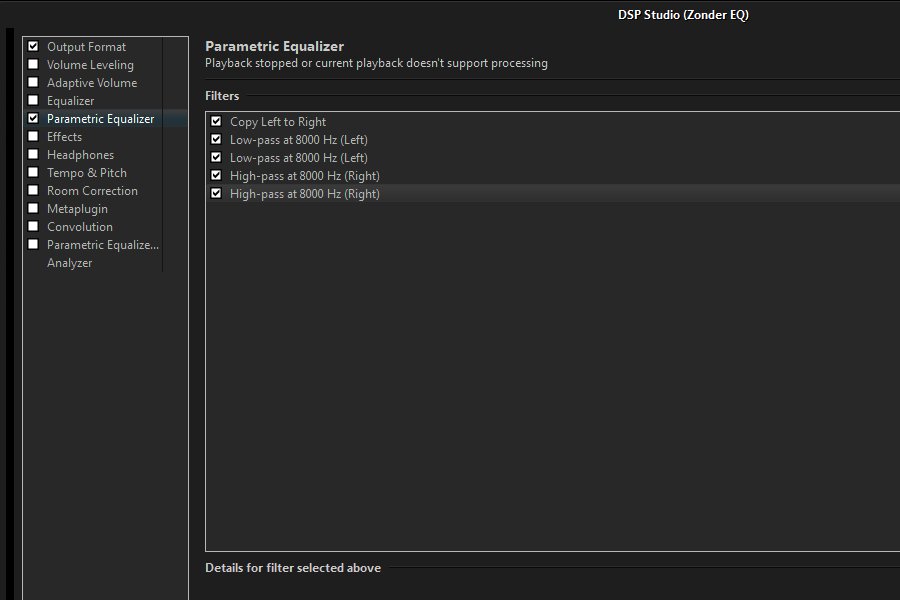
If we look in REW, after recording a Dirac pulse to disk we get this view of the frequency traces:
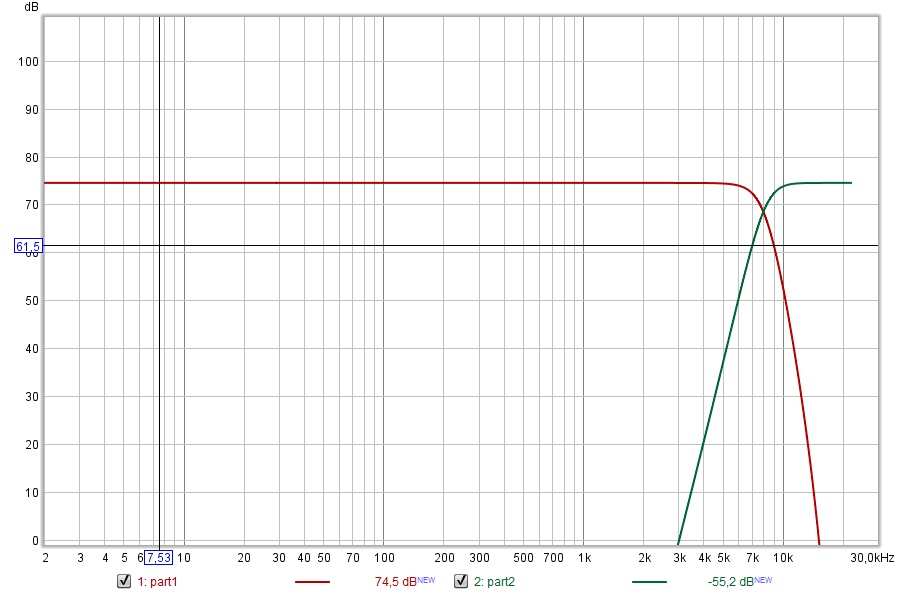
Filtering it with 1/3 octave at 8000 Hz shows us this:
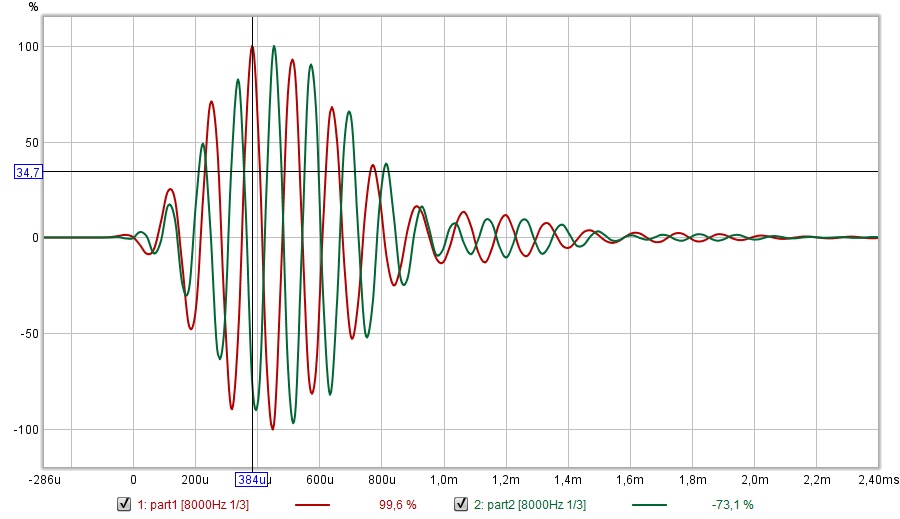
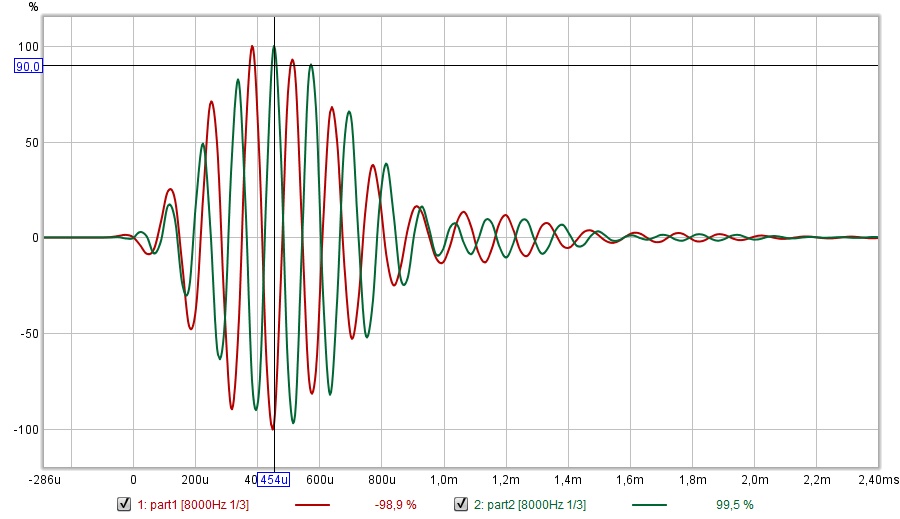
So there's a 0.07 ms difference between the two. I figured I'd have to delay the high frequency by 0.07 ms inside JRiver to get a perfect sum. Let's see what happens:

What do you know, it looks exactly the same... nothing happened. Then I remembered I have REW configured to set the impulse peak at 0. So that must be why I get exactly the same results here.
Importing both original traces again from example 1 with REW set to look for the first sample:
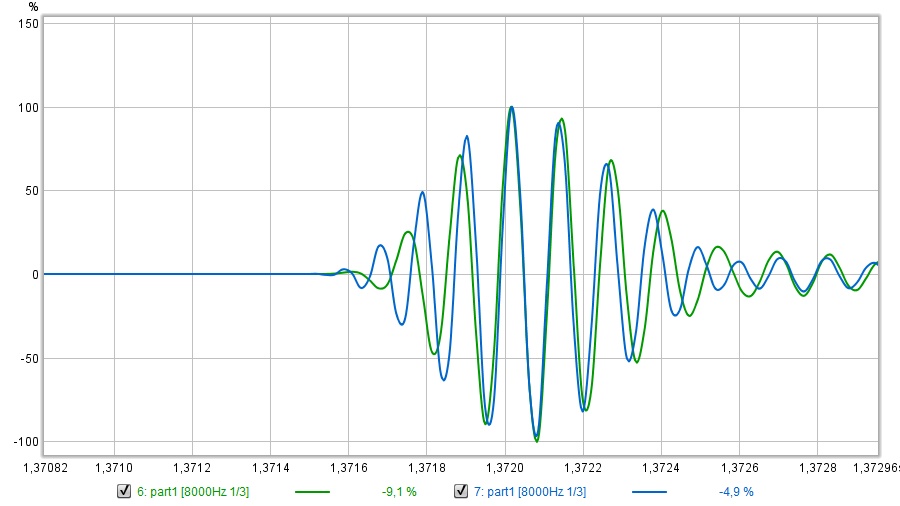
A perfect sum!
So if I were to add the right channel to the left, after these crossovers, without using any delay like this:
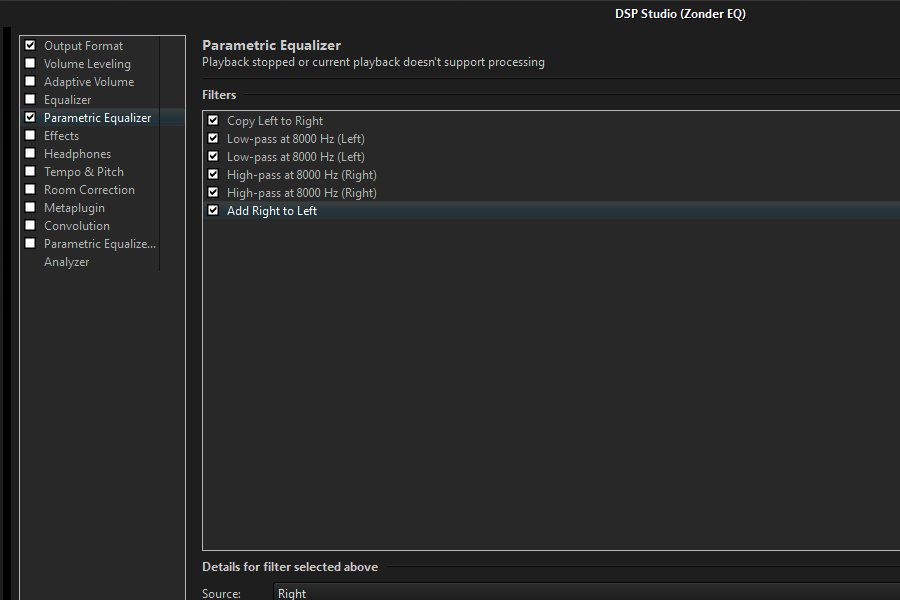
We get this as the end result:
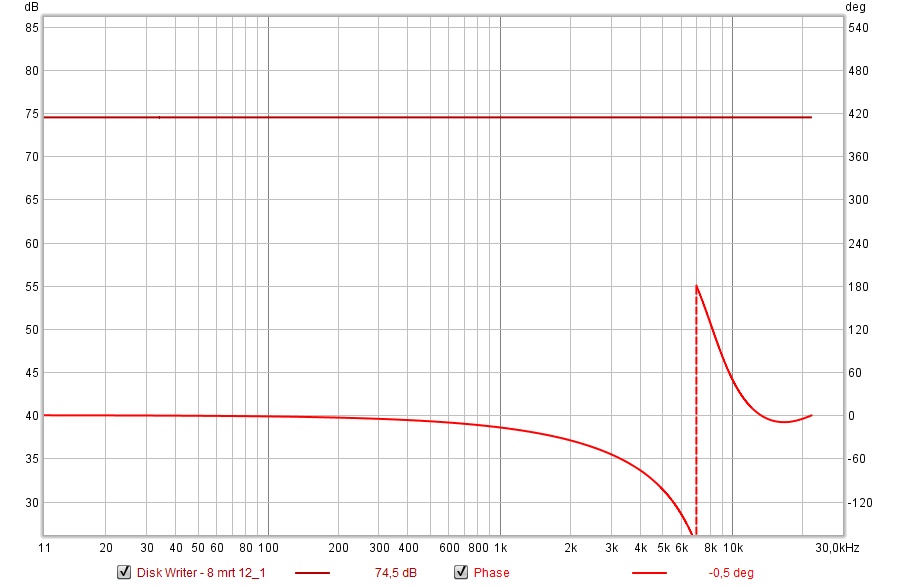
So when you set a crossover inside JRiver, in this case I used 2x Butterworth 24db/octave to get the LR8, it will sum together perfectly. So if the drivers acoustic centers are aligned, you'll get a perfect summed crossover.
JRiver's smallest delay is 0.01 ms, in real world distances that would be:

So that is just slightly more than 3 mm.
I'd say it will be harder to get your head equal distance to 2 drivers you're trying to sum than it is to get an acceptable sum in JRiver at 8 KHz. 🙂
I hope this proves that JRiver, even at version 22, is perfectly capable to handle Linkwitz Riley crossovers at higher frequencies.
Hi wesayso, a few things....
First, I don't know why we would ever question if JRiver can handle LR xovers (at any frequency).
I would think of course it can...whatever types and orders of xovers it lists, I would expect it handles them perfectly.
Where JRiver is lacking imo, is in the types and orders dept.
Odd order butterworths (beyond 1st order) are missing.
You can't cascade a BW1 and a BW2 to make a BW3.
(3rd order BW's are quite often helpful with subs, both as a hpf and xover.)
Bessel, perhaps the third most widely employed xover type, is missing..
Also don't understand why timing would be questioned for the LR8 example you presented, given that LR's are fully complementary and don't need any timing adjustment to sum correctly.
Unless maybe the point was to show how looking at 1/3 octave bandwidth filter impulses aligns the two sides???
So to try to figure out what/why you were showing, I replicated the experiment using live processor outputs instead of two filtered dirac pulses.
And your method of aligning the 1/3 bandwidth filtered impulses was the only way to obtain flat mag summation and a correct phase trace.
Neither REW's All SPL Time Align, or Align IR start, would do it.
Not any form of measurement, loopback with or without offset. Apply est shift.
No timing reference: Set peak to t=0, Set IR start to t=0.
Nothing provided spot on summation. ....whew..
Don't mean to be a freakin parrot...but bwack ! simple phase traces work !
The need for fine timing doesn't relate to head position at all really.
It's simply about the phase alignment of two drivers (on one speaker 🙂 sharing the same bandwidth.
Take the 8kHz example. One cycle, 360 degress, is 0.125ms. So 0.010ms equals 28.8 degrees of phase. We know phase wheel summation.
That gives about +/- .02ms lattitude for practical full summation of coincident drivers at 8kHz.
The coax CD's i use cross at 6.3k, and my 48k processor can only time to the nearest .02.....but it works.
If off by more than 1 sample, a definite shift in the sound of pink noise can be heard and measured at any listening position (one speaker).
Whether or not it can be heard in music I really doubt, but I use steep xovers to eliminate the range of mistiming's potential effect.
So really, it's not about stereo at all....just good basic mono reproduction.
The need for fine timing doesn't relate to head position at all really.
It's simply about the phase alignment of two drivers (on one speaker 🙂 sharing the same bandwidth.
Take the 8kHz example. One cycle, 360 degress, is 0.125ms. So 0.010ms equals 28.8 degrees of phase. We know phase wheel summation.
That gives about +/- .02ms lattitude for practical full summation of coincident drivers at 8kHz.
The coax CD's i use cross at 6.3k, and my 48k processor can only time to the nearest .02.....but it works.
If off by more than 1 sample, a definite shift in the sound of pink noise can be heard and measured at any listening position (one speaker).
Whether or not it can be heard in music I really doubt, but I use steep xovers to eliminate the range of mistiming's potential effect.
So really, it's not about stereo at all....just good basic mono reproduction.
Indeed it was only to show this stuff works as expected. I get that you're stuck in the way of straightening a driver and then use a named crossover. I don't feel the same need to do things that way. As a FIR filter can resolve it just as easily and can even resolve the timing issue.
If one would have to use timing and not wanting to solve it with FIR, there's always plugins that do just that. The free Voxengo sound delay plugin comes to mind, but there will probably be others as well that can delay in samples just like this free one. Stick it in something like Metaplugin and you can use it on all channels you'd like, each with their own settings.
There's always more than one way really. I'm pretty sure if you search for it there will probably be a Bessel solution in a plugin somewhere. As said before, JRiver can function as a host housing pretty much all you can ever wish for. With 'sub level' hosts like Metaplugin you can build pretty crazy stuff.
...The need for fine timing doesn't relate to head position at all really.
It's simply about the phase alignment of two drivers (on one speaker 🙂 sharing the same bandwidth.
Take the 8kHz example. One cycle, 360 degress, is 0.125ms. So 0.010ms equals 28.8 degrees of phase. We know phase wheel summation.
That gives about +/- .02ms lattitude for practical full summation of coincident drivers at 8kHz.
The coax CD's i use cross at 6.3k, and my 48k processor can only time to the nearest .02.....but it works.
If off by more than 1 sample, a definite shift in the sound of pink noise can be heard and measured at any listening position (one speaker).
Whether or not it can be heard in music I really doubt, but I use steep xovers to eliminate the range of mistiming's potential effect.
So really, it's not about stereo at all....just good basic mono reproduction.
Ha ha Mark, nice discussions there 🙂
Think there could be more trouble with digital time allignment be 100% on cycle in phase wheel especially the higher the frequency is, see below Klippel note 🙂
Attachments
The Motu 8A uses the same technology as my $200 cheaper Motu Ultralite MK IV. I'm not sure what the difference is. Analog output specs are almost identical. I hope mine measures as well.
I'm not sure what to make of the measurements in the review. They seem better than the Motu and chip specs. They also appear to be as low as the Keysight instrument is capable of measuring accurately. But I trust Keysight, they are the renamed HP Instruments division, which has a storied past.
The first chart shows a noise floor down over 150db from full scale. The paper fluid posted claimed only -137 db but I'm not sure that is apples to apples. With numbers like this, digital volume control seems perfectly OK.
The 2nd chart shows a -1db 1 khz output with 2nd harmonic down 125 db but the spec only claims THD+N of -110db. Since the noise is well below the visible harmonics, this THD+N is all HD. In successive charts the 1 khz output amplitude is reduced in 10 db steps and you can see the HD dropping down into the noise. HD finally disappears into the noise at -60db output level. Reading approximate numbers off the chart, the SNR at that level is still around 95 db.
So with a digital volume control, after turning the volume down 40 db you would still have circa 115 db SNR. That seems more than good enough for me as the NC500 amp is specced at only 110 db SNR at 2.83 volts output, SNR reducing with level as the noise at the output stays constant. As output level reduces amp noise rise relative to DAC noise and eventually becomes greater than it.
The thing to do with these Motu DACs is to set the peak signal level to the full +20dbU output instead of just to the level needed to drive the amp to its peak output. This is necessary to get full SNR from the DAC. It also maximizes the amount of attenuation you need at the input to the amp to set the maximum SPL wherever you want it. This attenuation reduces the DAC noise further relative to the amp noise.
I'm really not trying to convince anyone to get a new DAC, just trying to understand the issues and clean up my previous posts as I grope my way through the data. OTOH, its hard to deny these numbers and measurements. That is not to say one can't get equally or almost equally impressive noise performance from a state of the art 24-bit DAC. Those TI chips I looked at that are used in one of these DACs had a 130 db SNR spec, IIRC.
I'd still like confirmation that the Ultra MK4 actually shows 8 output channels within JRiver. I get it that it's a Left, Right and channels 1 till 6 but I don't get that the 8A simply shows 8 channels analog out.
Prices over here are not that far apart if one holds more promise than the other. Even though I currently use 6 channels, really having 8 available is worth something. (for future experiments)
I'd need to convert balanced back to single ended for two amplifiers, but I am interested in one of these Motu devices.
Even if I'd get 3 Universal Buffers first, I'd still could go this route and use 2 of them later on on the amp side to do the balanced to single ended conversion with unity gain (1 volt in is 1 volt out).
So thank you both for bringing it to my attention. 🙂
...Where JRiver is lacking imo, is in the types and orders dept.
Odd order butterworths (beyond 1st order) are missing.
You can't cascade a BW1 and a BW2 to make a BW3.
(3rd order BW's are quite often helpful with subs, both as a hpf and xover.)
Bessel, perhaps the third most widely employed xover type, is missing...
Copy below numbers on a piece of note should help set 2nd order Bessel or 3rd order Butterworth textbook slopes in Jriver, they my own hobby homebrew but should be 100% okay 🙂
Bessel 2nd order have frequency number relation of 1,27 relative to filter Bessel target setting, that is below example using 1000Hz number will be a 1,27x1000Hz=1270Hz BES2 target, and should BES2 target be 1000Hz then set below filters to 1000/1,27=787,4Hz:
Butterworth 3rd order:
Attachments
Last edited:
Thanks BYRTT for proving the point I made on another thread recently:
Together with the fixed crossovers one could use the PEQ tools and shelve functions and you can make the driver follow just about any curve you could ever desire.
Does anyone know if they Motu interfaces have access in system setting so one can dial in whatever of the 7 different reconstruction LP filters ESS offer, for example fluid's D50 and Okto have that flexibility so one can listen NOS whatever that should help : ) or set a good say > -80dB rejection at 22,05kHz for CD material.
The NOS filter on the 9018k2m is complete garbage, most of the others are good apart from the MQA style one. The D50 fortunately does not have this dreadful filter.
I have an old Phillips TDA NOS DAC and it sounds very good, the NOS filter in the Sabre does not do the same thing at all 🙂
The older 9018 chips just have two filters that are very difficult to tell apart from listening, their impulse responses are different though.
The newer 9028 and 9038 have more and some of the manufacturers have rolled their own, a function which was always there with the older chips.
IMO linear phase fast or slow are the way to go.
I have an old Phillips TDA NOS DAC and it sounds very good, the NOS filter in the Sabre does not do the same thing at all 🙂
The older 9018 chips just have two filters that are very difficult to tell apart from listening, their impulse responses are different though.
The newer 9028 and 9038 have more and some of the manufacturers have rolled their own, a function which was always there with the older chips.
IMO linear phase fast or slow are the way to go.
I did not find anything in the user guide: https://s3.amazonaws.com/motu-www-data/manuals/proaudio/UltraLite-mk4_User_Guide.pdf
- Home
- Loudspeakers
- Full Range
- The making of: The Two Towers (a 25 driver Full Range line array)











